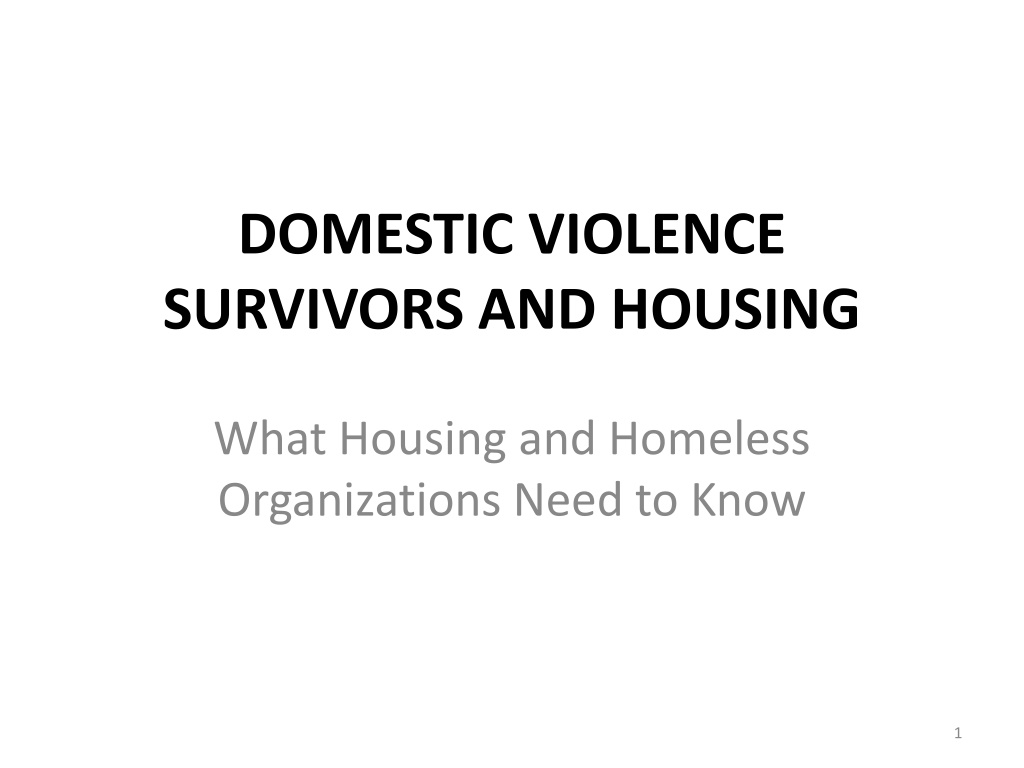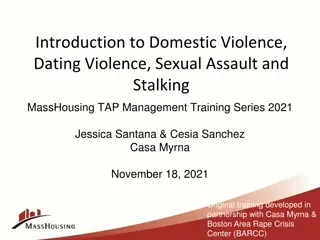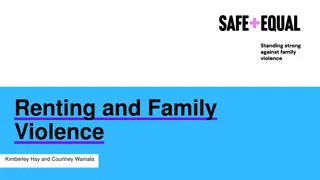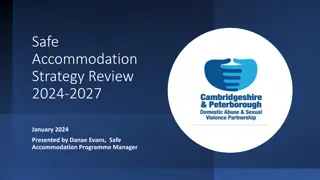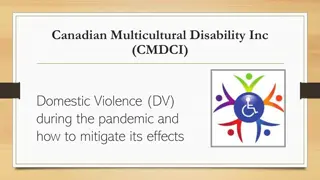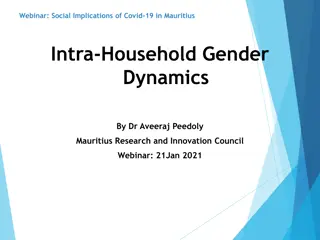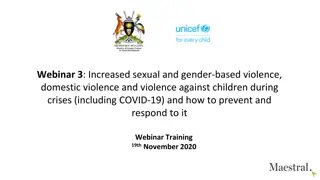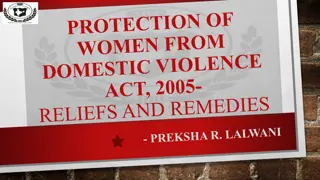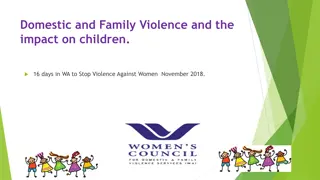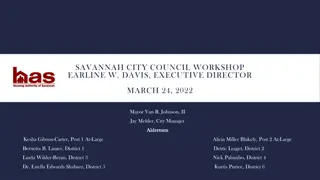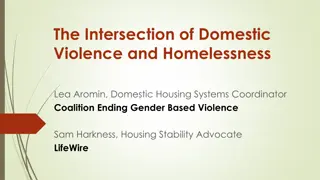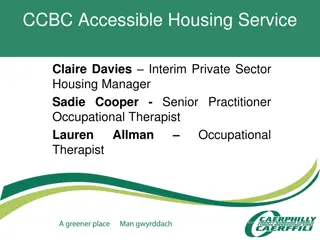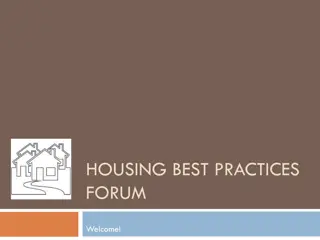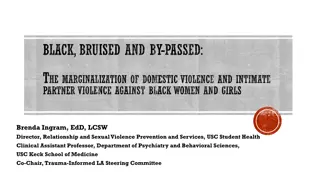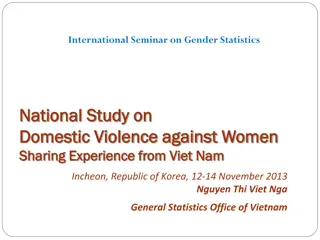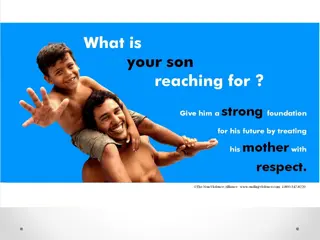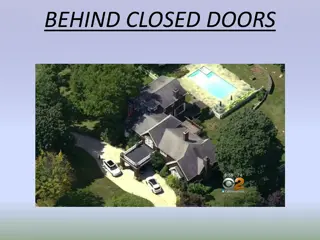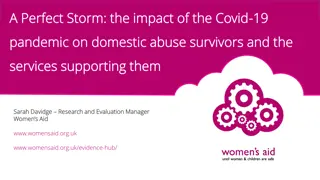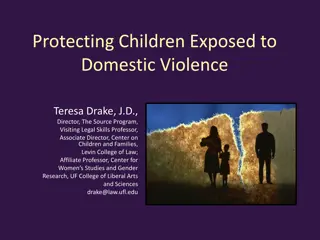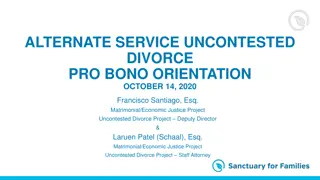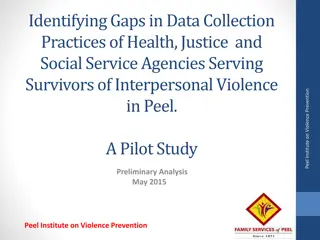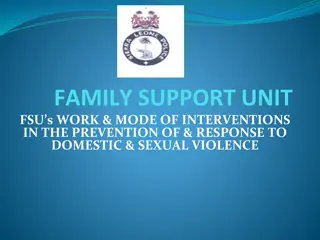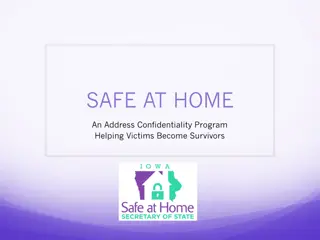Domestic Violence Survivors and Housing: What Organizations Need to Know
Critical link between domestic violence and homelessness is vital for housing and homeless organizations to effectively support survivors. Explore insights on recognizing and responding to DV, advocacy strategies, legal protections, scenarios for discussion, and essential resources to assist survivors in securing safe and stable housing. Gain valuable knowledge to empower survivors in breaking free from abusive relationships and overcoming housing insecurity.
Download Presentation

Please find below an Image/Link to download the presentation.
The content on the website is provided AS IS for your information and personal use only. It may not be sold, licensed, or shared on other websites without obtaining consent from the author. Download presentation by click this link. If you encounter any issues during the download, it is possible that the publisher has removed the file from their server.
E N D
Presentation Transcript
DOMESTIC VIOLENCE SURVIVORS AND HOUSING What Housing and Homeless Organizations Need to Know 1
OUTLINE 1. Domestic Violence and Homelessness (4-7) 2. Recognizing and Responding to DV (8-15) 3. Domestic Violence Advocacy (16-33) a) Confidentiality (17) b) Trauma-Informed (18-26) c) Safety (27-31) d) Voluntary Services (32-33) 2
OUTLINE (cont.) 4. Legal Protections for Domestic Violence Survivors (34-49) 5. Scenarios for Discussion (50-63) 6. Resources (64-65) 7. Acknowledgements (66) 3
Section 1: DV and Homelessness More than shelter . The availability of safe, affordable, and stable housing can make a critical difference in a woman s ability to escape an abusive partner and remain safe and independent. Without viable housing options, many battered women, particularly those already living in poverty, are forced to remain in abusive relationships, accept inadequate or unsafe housing conditions, or become homeless and perhaps increase their risk of sexual and physical violence. -Anne Menard 4
Why Talk About DV? DV is a leading cause of homelessness for women and children (families) in the U.S. o Survivors often must leave housing to escape DV o May be evicted due to abuser s behavior o DV interferes with ability to access housing - bad credit, poor rental histories, safety needs o Abusers sabotage survivor s economic stability - trouble paying deposit, rent and utilities 5
Housing Insecurity Homelessness is only one end of a continuum of housing problems faced by DV survivors Missed or late payments for rent/utilities Compromises: selling belongings or skipping food to make payments Ineligibility for housing services due to credit, landlord, or criminal justice problems Some families face barriers to using emergency shelters Disproportionate number of survivors of color among the homeless 6
Why Survivors May Go to Homeless Programs DV shelters lack capacity; often prioritize the highest degree of current DV danger (regardless of street danger) Over half of the survivors who identify a need for housing services upon fleeing abusive homes don t receive them Survivors often faced with choice of return to abuse or coping with chronic homelessness with little hope of housing 7
Section 2 RECOGNIZING AND RESPONDING TO DOMESTIC VIOLENCE 8
Identification and Screening Some survivors self-identify or are referred by DV agency For others welcome/intake protocol must include asking about DV safely, respectfully, and universally Survivor and abuser may show up together, both needing services program must address safety issues without victim blaming or increasing danger 9
Common Pitfalls Screening out due to danger Unintentionally re-victimizing or increasing danger - usually via policies meant to increase safety (ex. requiring a protective order) Forgetting the survivor is the expert in her own life and situation Competing instead of collaborating 10
A Few Practices to Avoid Asking survivor about DV in abuser s presence Giving her written materials when it s not safe Blaming her for damage or danger caused by the abuser Expecting she can control his behavior (ex. showing up at her unit uninvited) Setting eligibility criteria that prevent access to services or increase danger 11
Pairing Housing Help with DV Know-How is Powerful DV interferes with housing access and with success in maintaining it Even once in new housing, abuse may remain an issue; abusers often sabotage attempts to live independently, and some trauma impacts are slow to resolve Survivors who can t maintain their housing are highly vulnerable to return/re-abuse Specialized, DV-informed, tailored services can address these interacting factors and be the difference in survivors ability to truly embed safety in their lives 12
Understanding the Dynamics DV is a pattern of coercive power and control Abuser s behavior often affects survivor s choices and behavior both to increase her own safety and to cope Survivors have real fears, beyond physical safety (ex. deportation; losing custody) May seem difficult to identify victim vs. abuser 13
The Need for a DV Lens Denials, evictions, ruined credit, lease terminations often based on violence/abuser interference Survivors experience discrimination based on status as victims High density/high violence in public housing complexes may place women at continued risk, trigger trauma Stalking, harassment, on-going violence and threats by the perpetrator may occur even after survivor is housed 14
The Need for a DV Lens: Children More than half of DV survivors live in households with children under 12 47% of homeless school-aged children and 29% of homeless children under 5 have witnessed domestic violence in their families Exposure to violence significantly impacts on development, behavior, education, health, mental health, and increased risk- taking behaviors as adolescents and adults 15
Section 3 DOMESTIC VIOLENCE ADVOCACY Trauma Informed, Survivor Driven Strength Based Emotional & Physical Safety Oriented Voluntary Services Approach Self Directed 16
Confidentiality: The Cornerstone Federally funded programs (VAWA, HUD) have statutory requirements to protect survivor confidentiality Best practice is to afford all survivors basic safeguards of confidentiality, regardless of statute or funding (ex. Release of Information) Examine all program aspects for breaches of confidentiality use of technology, sharing paperwork, using personally identifying info. in public, etc. When in doubt, ask her. Which info. is OK to share? Is it OK to leave a message? Should we have a code word? 17
Issues That Can Challenge Stabilization Trauma impacts (survivor and children) Ongoing legal issues Fears about child custody, deportation Stalking-prone abuser Interrupted/sabotaged employment history Criminal record Chemical dependency Bad credit, inexperience with handling money Pets often part of the household 18
Keying in on Trauma Trauma: When external threat overwhelms coping resources; for survivors, an ongoing state of being Brain becomes hyper-vigilant scanning for danger, sensing/reacting to perceived threat PTSD symptoms are seen as the behavioral manifestation of all of these changes Trauma responses are completely normal for a human being who s adapted to a traumatizing life BUT may interfere with survivors ability to enact patterns and behaviors it takes to maintain housing Trauma also affects how people approach services 19
How Trauma May Show up Difficulty with emotional regulation Hyper-arousal, flashbacks, nightmares, startle reaction Memory and concentration problems Pain, sleep disturbances, illness, substance abuse issues Short attention span; easily distracted Slowed thinking, difficulty with decisions Intrusive thoughts, confusion Changed sense of self, others, and the world Loss of sense of time and space Trouble with abstract concepts, complex directions 20
Survivors May Need Advocacy Around Trauma Trauma may be mistaken for: Apathy Poor self-worth Lack of follow-through, unreliability Disinterest in getting help Uncooperative or oppositional manner Spaciness Poor judgment, inability to make good choices Deeper mental health issues 21
Historical Trauma Also called multi-generational trauma or trans-generational trauma Trauma that is passed on from one generation to the next because of psychological, social, and environmental traumatic conditions and stressors that are unresolved within a family system, community, or population 22
Destruction of Culture The trauma inflicted on people was also directed at the removal and destruction of culture. Language, spirituality, sense of family structure were systematically destroyed. Boarding schools were a place that systematically attempted to destroy the family system and the sense of family. The destruction of culture left many people empty and searching for their soul. 23
Why is this important? Many of the problems we face in families and communities can be directly linked to the multi-generational/trans-generational trauma. For each generation that doesn t address historical trauma, the trauma effects carry forward to the next generation. 24
Internalized Oppression Violence gone inward; when violence gets internalized we then see some of the following: 1. Addictive behaviors 2. Depression/suicidal ideation 3. Chronic physical problems such as diabetes, hypertension These life conditions can be interpreted as violence towards one s self. 4. Loss of identity making it easier to commit violence towards one s self or the ones closest to us. 25
Where do we go from here? Interventions must include socio-historical factors Community programs must insist on cultural competency, otherwise the historical trauma continues to be reinforced People working in the community must know and demonstrate that they have competency to work in the community Trans-generational trauma must be addressed by providers and they must take responsibility for their part in this history 26
How Can Your Program Help with Safety? Have policies in place with your DV agency partner for emergent needs Help the victim with other safe housing resources within your program or another program Help the abuser with resources if s/he becomes homeless due to exclusion from the unit Don t judge or restrict the level of contact they might need to have with each other 27
Immediate Safety Listen to the survivor and ask what s/he needs If the abusive partner is also a resident or housing applicant, do not have safety-related conversations with him/her present Remember that the victim may use violence in self defense or to regain control over her/his life Utilize your DV agency partnership either as a referral or for consultation 28
Conversations Safety planning is a process, not a one-time event or check list. Safety planning is tailored to the survivor s life and daily activities each day may even be a little different. Ask the survivor what the abuser s power and control tactics are. Survivor activities and abuser s tactics will guide the safety planning process. 29
Understanding the Abusers Role Does he have visitation? Was he the primary babysitter/transportation, etc.? Support vs. safety vs. isolation Is he sabotaging her efforts? 30
Long-Term Safety Planning Once a survivor has obtained alternate/transitional or permanent housing, maintaining safety remains a priority Safety at home and with children Financial safety and independence Safety on the job and in pubic settings Safety if I am using drugs or alcohol 31
Voluntary Services Based on a philosophy and framework that emphasizes providing information and encouraging true choice Also called Empowerment Model, Harm Reduction, etc. term is less important than underlying principles and practices Shelter/housing eligibility is NOT contingent upon accessing support services Participant-driven and relationship-based Intentionally focuses on whole person, including historical and relational context, not a singular issue or deficit 32
Common Misconceptions Voluntary Services means: No rules, no expectations A hands-off approach; participants always have to initiate contact Participants will sit around and do nothing Staff can never intervene, even in a crisis No-one can ever be terminated from services Never knowing if your program is working 33
Section 4 LEGAL PROTECTIONS FOR DV SURVIVORS 34
Violence Against Women Act 2005 Housing Strategies. Housing and Urban Development (HUD) Agency reporting requirements imposed on public housing applicants must include any plans to address domestic violence, dating violence, sexual assault and stalking in their application. McKinney-Vento Homeless Assistance Act and HMIS. Homeless Management Information Systems must protect the confidentiality of victims of domestic violence, dating violence, sexual assault and stalking seeking housing assistance. It requires that grantees and sub-grantees of HUD funding reasonably protect the identity of victims by refraining from disclosing personally identifying information. This section would also prevent the Secretary from requiring a grantee to disclose the identity of a client if the grantee reasonably believes that client is the victims of domestic violence, dating violence, sexual assault, or stalking. 35
Low Income Housing Voucher Program & Public Housing - 42 U.S.C. 1437f & 42 U.S.C. 1437d. Someone who otherwise qualifies for admission or assistance cannot be denied admission to public housing or denied a Section 8 voucher on the grounds that the person is or has been a victim of domestic violence, dating violence or stalking. These provisions further provide incidents of actual or threatened domestic violence, dating violence, or stalking will not be construed as a serious or repeated violation of a lease and cannot be good cause for terminating the tenancy or participation in the voucher program. 36
Voucher/Public Housing (cont.) Additionally, they provide that the one-strike rule does not permit termination of the tenancy of an individual who is a victim of domestic violence, dating violence, or stalking based on criminal activity directly relating to such violence. However, the one-strike rule may still apply if the Public Housing Authority (PHA) or Section 8 landlord can show an actual and imminent threat to other tenants or those employed at or providing service to the property if the tenancy or voucher assistance is not terminated. Additionally, PHAs and Section 8 landlords may still terminate an abuser s tenancy, bifurcating a lease if necessary to allow the rest of the household to remain. 37
Voucher/Public Housing (cont.) Provide that when a family holding a Section 8 voucher moves out of a unit to protect the safety of a victim of domestic violence, dating violence, or stalking who reasonably believed she would be in danger if she remained in the unit, the family may retain the voucher even if the move was in violation of a lease (so long as the family has met all other lease requirements). Previously, moving out in violation of a lease would have rendered a family ineligible for voucher assistance. 38
Voucher/Public Housing (cont.) When an individual claims that her tenancy or assistance should not be terminated because she is a victim of domestic violence, dating violence, or stalking, a PHA or Section 8 landlord may request proof that she is a victim. Acceptable proof includes certification from an attorney, domestic violence service provider, or medical professional, or a police or court record. An individual has at least 14 business days to provide the documentation. However, the public housing agency is not required to demand documentation or physical proof of the individual s status as a victim of domestic violence, dating violence, or stalking in order to grant the protection described above. 39
Voucher/Public Housing (cont.) The provisions also require PHAs and Section 8 landlords to provide notice to tenants of their rights under VAWA and to revise leases and housing assistance payment contracts with Section 8 landlords in accordance with these protections. 40
Amendments in VAWA 2013 Sec. 601. Housing protections for victims 42 U.S.C. 41411 Expands housing protections from VAWA 2005 to new covered federal housing programs: USDA Rural Housing properties (42 USC 1471) Low-Income Housing Tax Credit properties (26 USC 42 (h) &(i)) HUD s McKinney-Vento homeless programs (42 USC 11375; 11386; 11408) HOME Investment Partnerships program (42 USC 12755) Section 221(d)(3) Below Market Interest Rate (BMIR) Program (12 USC 1715z-1b) Section 236 Rental Program (12 USC 1715z-1b) HOPWA housing program Section 202 supportive housing for the elderly and Section 811 supportive housing for people with disabilities 41
VAWA 2013 (cont.) Maintains protections for currently covered programs: public housing, Section 8 vouchers and Project-based Section 8 Continues to bar eviction/termination due to status as victim and require landlords to maintain Victim-tenant confidentiality, protections included in VAWA 2005 Adds sexual assault victims to those protected by this section Requires notice to tenants of these rights Requires housing agencies to develop model emergency transfer plans No authorization; cost-free 42
Homeless Management Information System (HMIS) in Washington State Domestic violence agencies ( victim services agencies ) are exempt from entering personally identifying information into HMIS in accordance with Federal Law RCW 43.185C.180 helps protect DV survivors seeking shelter or housing services outside of a domestic violence agency Personally identifying information about homeless individuals for the Washington homeless client management information system may only be collected after having obtained informed, reasonably time limited (i) written consent from the homeless individual to whom the information relates, or (ii) telephonic consent from the homeless individual, provided that written consent is obtained at the first time the individual is physically present at an organization with access to the Washington homeless client management information system. Safeguards consistent with federal requirements on data collection must be in place to protect homeless individuals' rights regarding their personally identifying information. 43
Washington State Law Residential Landlord Tenant Act RCW 59.18.580: No adverse rental decisions If tenant or applicant is victim of domestic violence, sexual assault or stalking: Landlord may not terminate tenancy for that reason May not fail to renew a tenancy May not refuse to enter into a rental agreement Landlord cannot make adverse rental decision if tenant has previously terminated a rental agreement due to DV, SA, stalking Defense to unlawful detainer if tenant is victim Penalty for violation-civil damages sustained by tenant plus court costs, attorney fees Does not preclude adverse decisions based on other lawful factors Tenant screening providers cannot disclose victim status or that someone previously terminated a lease due to victimization 44
RCW 59.18.575 Notice to landlord-termination of rental agreement Notice in writing that tenant or household member is victim of DV, sexual assault, or stalking And has either a valid protection order OR Has reported the DV, SA, or stalking to qualified third party who has provided the tenant, or household member a written report signed by the third party Sample form for third party provided in statute (does not have to be exactly the same, but substantially in that format) Sample form is NOT required to include the alleged perpetrator s name, unless the alleged perpetrator is a landlord and it is requested in writing Providing such a verification does NOT waive advocate privilege 45
Termination of Rental Agreement Tenant discharged from obligation to pay rent at the end of the month. The tenant still is liable for the rent for the current month (with minor exceptions) Tenant entitled to return of full deposit (other than damages, etc) Other tenants on the rental agreement who are not victims are still obligated by lease Victims of sexual assault, stalking or other unlawful harassment by the landlord can terminate without prior report to third party or getting copy of protection order 46
Changing Locks If tenant gets a court order granting possession of unit, the tenant can ask that the locks be changed at the tenant s expense, and not provide copy of keys to tenant restrained or excluded. Person excluded under the court order may still be liable under the rental agreement-RCW 59.18.585 If landlord is perpetrator, tenant can change or add locks to unit 47
Criminal Legal System A good relationship with local law enforcement is necessary for any housing/homeless provider Keep in mind that a survivor may not necessarily want law enforcement involvement for many reasons: Immigrant and has fears about police from country of origin Doesn t want partner arrested (income source or potential to be deported) Undocumented immigrant May have warrants From historically oppressed community; police intervention not viewed as helpful or welcome 48
Civil Legal System Protection Orders order issued by the court as a result of a petition by victim for protection from abuser Orders must be observed in any jurisdiction (Full Faith & Credit) Survivors may not choose to petition for an order due to safety concerns important that the program not require her to get a protection order 49
Section 5 NOW WHAT DO I DO?! SCENARIOS FOR DISCUSSION 50
